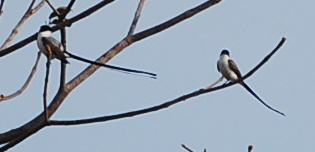Forked Tail Flycatcher

 This bird occurs in a wide variety of habitats including pastures, riparian forests, and open residential areas with scattered trees. Its breeding range is from central Mexico to central Argentina. In most of this range it is usually found year-round, but in the southern parts of its range itretreats northward for the winter. This species is also known to wander widely. It occurs almost annually in the eastern United States seaboard and Canada.
This bird occurs in a wide variety of habitats including pastures, riparian forests, and open residential areas with scattered trees. Its breeding range is from central Mexico to central Argentina. In most of this range it is usually found year-round, but in the southern parts of its range itretreats northward for the winter. This species is also known to wander widely. It occurs almost annually in the eastern United States seaboard and Canada.
This flycatcher builds a shallow cup nest 1–10 m high in a shrub or short tree. Females normally lay 2 or 3 eggs.
The Fork-tailed Flycatcher is white below, gray above and has a black cap. Males sometimes show a yellow crown stripe. Males also have an extremely long forked tail, about the same length as that of their cousin, the Scissor-tailed Flycatcher. Females have a somewhat shorter tail, while it is significantly shorter in juveniles. Males are 37–41 cm in length; females, 28–30 cm, including tail. It weighs 28–32 g. The scissor-tailed flycatcher has been reported to be over 40 cm long.
This species is primarily an insectivore, but will switch to berries and small fruits during winter if insects become scarce.
Source: http://www.wikipedia.org/
